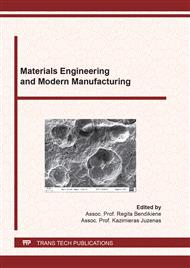[1]
C. Winter, A.C. Borges, M. Elizabeth, R. Schultz, M. Gutterres, Influence of pigment addition on the properties of Polymer films for leather finishing, J. Soc. Leather. Technol. Chem. 101 (2017) 78-85.
Google Scholar
[2]
M.J. Osgood, Pigments in modern leather finishing, J. Soc. Leather Technol. Chem. 74 (1990) 1-6.
Google Scholar
[3]
O. Mokrousova, O. Pleten, E. Kasyan, Pigment concentrate with montmorillonite for leather coat finishing, in: M. Pawlowa, I. Frydrych (Eds), Innovations in clothes and footwear, Radom. (2010) 391-396.
Google Scholar
[4]
A. Mahmoodi, M. Ebrahimi, A. Khosravi, E. Mohammadloo, A hybrid dye-lay nano-pigment: Synthesis, characterization and application in organic coatings, Dyes and Pigments. 147 (2017) 234-240.
DOI: 10.1016/j.dyepig.2017.08.009
Google Scholar
[5]
A. Marzec, B. Szadkowski., J. Rogowski, W. Maniukiewicz, P. Rybiński, M. Prochoń, New organic/inorganic pigments based on azo dye and aluminum-magnesium hydroxycarbonates with various Mg/Al ratios, Materials. 12 (2019) 1349-1364.
DOI: 10.3390/ma12081349
Google Scholar
[6]
M. Jianzhong, Z. Zhijie, L. Lingyun et al, Application of acrylic resin coating agent modified by nano SiO2, J. Soc. Leather Technol. Chem. 90 (2006) 188-192.
Google Scholar
[7]
Y. Onur, A hybrid polyacrylate/OMMT nanocomposite latex: Synthesis, characterization and its application as a coating binder, Prog. Org. Coat. 77 (2014) 110-117.
DOI: 10.1016/j.porgcoat.2013.08.008
Google Scholar
[8]
A. Danylkovych, O. Mokrousova, O. Okhmat, Technology and materials of leather production, Phoenix, Kyiv, (2009).
Google Scholar
[9]
I.A. Kazarinov, N.A Konoplyantseva, I.M. Gamayunova, Physical and colloid chemistry, Saratov, (2006).
Google Scholar
[10]
A. Danylkovych, V. Chursyn, Analytical control in the production of leather and fur. Moscow, (2014).
Google Scholar
[11]
O. Mokrousova, Technology of obtaining of mineral pigment concentrate for leather manufacturing, Herald of KNUTD. 3 (2011) 67-74.
Google Scholar
[12]
L.K. Koopal, L. Keltjens, Adsorption of ionic surfactants on charged solids: adsorption. Colloids Surf .17 (1986) 371.
DOI: 10.1016/0166-6622(86)80260-8
Google Scholar
[13]
L. Koopal, Ion Adsorption on Homogeneous and Heterogeneous Surfaces in: H. Stechemesser, B. Dobias (Eds), Coagulation and flocculation, Taylor & Francis Group, LLC, (2005) 217-348.
DOI: 10.1201/9781420027686.ch5
Google Scholar
[14]
R.S. Cameron, B.K. Thornton, R.S. Swift, Molecular weight and shape of humic acid from sedimentation and diffusion measurements on fractionated extracts, J. Soil. Sci. 23 (1972) 398-408.
DOI: 10.1111/j.1365-2389.1972.tb01670.x
Google Scholar


